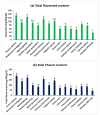In Vitro Antioxidant and Bactericidal Efficacy of 15 Common Spices: Novel Therapeutics for Urinary Tract Infections?
- PMID: 31248181
- PMCID: PMC6630587
- DOI: 10.3390/medicina55060289
In Vitro Antioxidant and Bactericidal Efficacy of 15 Common Spices: Novel Therapeutics for Urinary Tract Infections?
Abstract
Background and Objectives: Bacterial urinary tract infection (UTI) is the most common ailment affecting all age groups in males and females. The commercial antibiotics usage augments antibiotics resistance and creates higher recurrence rates of such communal infections. Hence, this study is aimed at investigating the antibacterial and antioxidant potentials of 15 common spices against 11 UTI-causing bacterial pathogens. Materials and Methods: The antioxidant potential of the methanolic extracts was analyzed as contents of total phenols and flavonoids; radical scavenging, total reducing power, the ferric reducing power assay. Urinary pathogens were subjected to spice extracts to investigate antibacterial assays. Results: Preliminary phytochemical study of spices was performed to find those containing alkaloids, flavonoids, phenolic compounds, and steroids that can be recognized for their noteworthy bactericidal effects. The outcome of the antioxidative potential from the four methods demonstrated the sequence of potent antioxidant activity: Acorus calamus > Alpinia galanga > Armoracia rusticana > Capparis spinosa > Aframomum melegueta. The total polyphenols and flavonoids in the studied species positively correlated with their antioxidant properties. The four most effective spices (A. calamus, A. galanga, A. rusticana, and C. spinosa) had a zone of inhibition of at least 22 mm. A. calamus, A. melegueta, and C. spinosa had the lowest minimum inhibitory concentration (MIC) value against Enterobacter aerogenes, Staphylococcus aureus and Proteus mirabilis. All 15 spices had the lowest minimum bactericidal concentration (MBC) value against most of the pathogenic bacteria. Conclusion: The four highly potent and unique spices noted for the in vitro control of UTI-causing pathogens could be pursued further in the development of complementary and alternative medicine against UTI-causing pathogens.
Keywords: MBC; MIC; antibacterial activity; antioxidant; spices; uropathogens.
Conflict of interest statement
The authors declare no conflicts of interest
Figures




Similar articles
-
Antioxidant, antibacterial activity, and phytochemical characterization of Melaleuca cajuputi extract.BMC Complement Altern Med. 2015 Oct 24;15:385. doi: 10.1186/s12906-015-0914-y. BMC Complement Altern Med. 2015. PMID: 26497742 Free PMC article.
-
Polarity of extracts and fractions of four Combretum (Combretaceae) species used to treat infections and gastrointestinal disorders in southern African traditional medicine has a major effect on different relevant in vitro activities.J Ethnopharmacol. 2014 Jun 11;154(2):339-50. doi: 10.1016/j.jep.2014.03.030. Epub 2014 Mar 25. J Ethnopharmacol. 2014. PMID: 24681040
-
Chemical composition of Mentha pulegium and Rosmarinus officinalis essential oils and their antileishmanial, antibacterial and antioxidant activities.Microb Pathog. 2017 Oct;111:41-49. doi: 10.1016/j.micpath.2017.08.015. Epub 2017 Aug 15. Microb Pathog. 2017. PMID: 28821401
-
Antimicrobial Activity of Spices Popularly Used in Mexico against Urinary Tract Infections.Antibiotics (Basel). 2023 Feb 3;12(2):325. doi: 10.3390/antibiotics12020325. Antibiotics (Basel). 2023. PMID: 36830236 Free PMC article. Review.
-
Therapeutic potential of medicinal plants for the management of urinary tract infection: A systematic review.Clin Exp Pharmacol Physiol. 2019 Jul;46(7):613-624. doi: 10.1111/1440-1681.13092. Epub 2019 Apr 22. Clin Exp Pharmacol Physiol. 2019. PMID: 30932202
Cited by
-
Alternative Therapeutic Options to Antibiotics for the Treatment of Urinary Tract Infections.Front Microbiol. 2020 Jul 3;11:1509. doi: 10.3389/fmicb.2020.01509. eCollection 2020. Front Microbiol. 2020. PMID: 32719668 Free PMC article. Review.
-
Caper (Capparis spinosa L.): An Updated Review on Its Phytochemistry, Nutritional Value, Traditional Uses, and Therapeutic Potential.Front Pharmacol. 2022 Jul 22;13:878749. doi: 10.3389/fphar.2022.878749. eCollection 2022. Front Pharmacol. 2022. PMID: 35935860 Free PMC article. Review.
-
Anti-Fungal Efficacy and Mechanisms of Flavonoids.Antibiotics (Basel). 2020 Jan 26;9(2):45. doi: 10.3390/antibiotics9020045. Antibiotics (Basel). 2020. PMID: 31991883 Free PMC article. Review.
-
Efficacy and Mechanism of Traditional Medicinal Plants and Bioactive Compounds against Clinically Important Pathogens.Antibiotics (Basel). 2019 Dec 9;8(4):257. doi: 10.3390/antibiotics8040257. Antibiotics (Basel). 2019. PMID: 31835403 Free PMC article. Review.
-
Efficacy and Mechanisms of Flavonoids against the Emerging Opportunistic Nontuberculous Mycobacteria.Antibiotics (Basel). 2020 Jul 27;9(8):450. doi: 10.3390/antibiotics9080450. Antibiotics (Basel). 2020. PMID: 32726972 Free PMC article. Review.
References
-
- Ditkoff E.L., Theofanides M., Aisen C.M., Kowalik C.G., Cohn J.A., Sui W., Rutman M., Adam R.A., Dmochowski R.R., Cooper K.L. Assessment of practices in screening and treating women with bacteriuria. Can. J. Urol. 2018;25:9486–9496. - PubMed
MeSH terms
Substances
LinkOut - more resources
Full Text Sources
Medical

